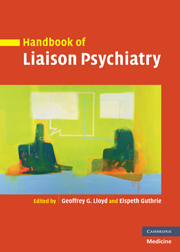Book contents
- Frontmatter
- Contents
- List of contributors
- Preface
- Part I Basic skills
- Part II Common psychiatric problems across the general hospital
- Part III Working with specific units
- 14 Neurological disorders
- 15 Cardiorespiratory disorders
- 16 Gastrointestinal disorders
- 17 Liver disorders
- 18 Endocrine disorders
- 19 Diabetes
- 20 HIV and AIDS
- 21 Renal disease
- 22 Musculo-skeletal disorders
- 23 Oncology
- 24 Head and neck cancer
- 25 Palliative care
- 26 Cosmetic procedures
- 27 Perinatal and gynaecological disorders
- 28 The intensive care unit
- 29 The burns unit
- 30 Psychocutaneous disorders
- 31 Genitourinary disorders
- 32 The emergency department
- Part IV Treatment
- Part V Different treatment settings
- Index
- References
24 - Head and neck cancer
from Part III - Working with specific units
Published online by Cambridge University Press: 10 December 2009
- Frontmatter
- Contents
- List of contributors
- Preface
- Part I Basic skills
- Part II Common psychiatric problems across the general hospital
- Part III Working with specific units
- 14 Neurological disorders
- 15 Cardiorespiratory disorders
- 16 Gastrointestinal disorders
- 17 Liver disorders
- 18 Endocrine disorders
- 19 Diabetes
- 20 HIV and AIDS
- 21 Renal disease
- 22 Musculo-skeletal disorders
- 23 Oncology
- 24 Head and neck cancer
- 25 Palliative care
- 26 Cosmetic procedures
- 27 Perinatal and gynaecological disorders
- 28 The intensive care unit
- 29 The burns unit
- 30 Psychocutaneous disorders
- 31 Genitourinary disorders
- 32 The emergency department
- Part IV Treatment
- Part V Different treatment settings
- Index
- References
Summary
Introduction
Head and neck cancer is the sixth most common cancer worldwide and within the developed world ranks third (Boyle et al. 1992; Parkin et al. 1999). Ninety per cent of these cancers are squamous cell carcinomas, and comprise 4% of all cancers in the USA and 5% in the UK. Internationally there has been an increase in central and eastern Europe (Macfarlane et al. 1994). An incidence of 10.2 lip, mouth and pharyngeal cancers per 100 000 population in the UK in 1996 was reported (2940 new cases) (Quin 2001). Men are more likely than women to succumb to the disease by a ratio of 3:1 although this disparity between the sexes is becoming less pronounced in the UK.
Mortality rates are high at 54% overall (Johnson 2002). A cohort of 200 oral cancer patients from the north-west of England showed an overall two-year survival probability of 72% falling to 64% at five years (Woolgar et al. 1999). Prognosis of small oral cancer lesions is better than large lesions. For instance, the median survival time of a patient with a lesion greater than 4 cm in diameter is four years less than a patient of similar age with a smaller lesion (Platz et al. 1986). The overall health of head and neck cancer patients tends to be worse than their age-matched counterparts in the general public (Funk et al. 1997).
Recurrence rates for head and neck cancer are comparatively high. In the series of 200 patients reported by Woolgar et al. (1999) the local recurrence rate resulting in death was 18%.
Keywords
- Type
- Chapter
- Information
- Handbook of Liaison Psychiatry , pp. 564 - 591Publisher: Cambridge University PressPrint publication year: 2007



